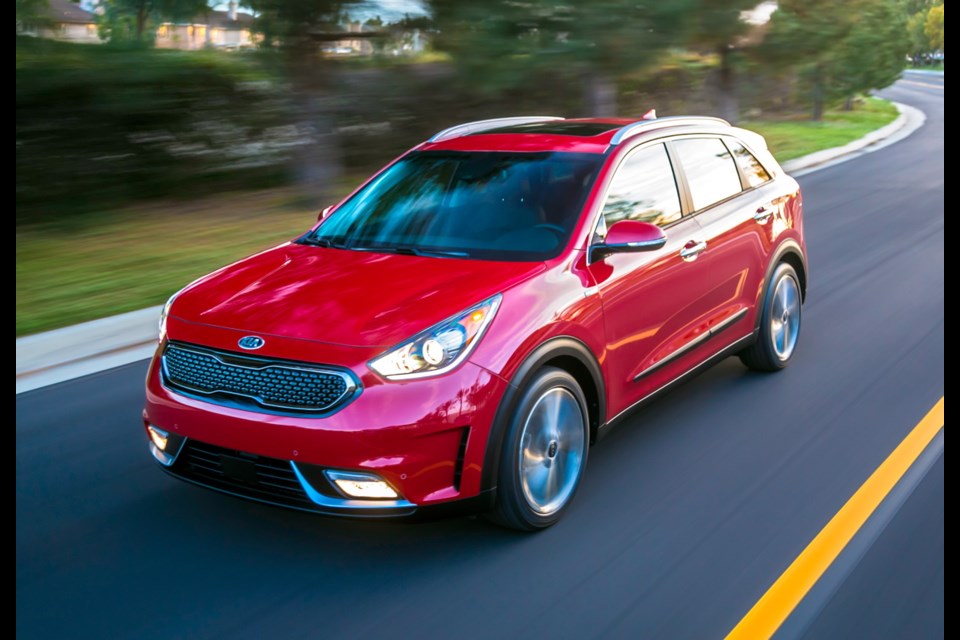Canadians love the practicality of tall wagons and small SUVs. With some of the most expensive gas prices on the continent, we on the West Coast also like fuel-efficient vehicles.
Toss those elements together and you get the new 2017 Kia Niro, marketed as a crossover/hybrid by the south Korean company.
The designation by Kia is no mistake. Crossovers and SUVs are top of mind with buyers these days.
Sizewise, the Niro falls somewhere between the original Toyota Prius and the larger Prius V, both with a similar gasoline/electric powerplant. But the Prius is a five-door hatchback and the Prius V is a large wagon — not a crossover, leaving an opening for the Niro to exploit.
While both Prius models are the market leaders in the hybrid segment, Kia is perhaps trying to win over buyers who would like to save gas and have a crossover as well.
If you have been car shopping and have been considering a Hyundai, a peek under the hood of a Niro may bring a sense of déjà vu, as the powerplant is shared with the Ioniq hybrid.
Power is in the form of a 1.6-litre, four-cylinder engine producing 104 horsepower and 109 foot-pounds of torque. The electric engine puts out 43 hp and 125 lb.-ft. of torque, with a combined total of 139 hp and 195 lb.-ft. of torque.
Unlike the Prius, Kia (and Hyundai) uses a six-speed automatic to get the power to the wheels.
The Niro is available in LX, EX and SX trim levels, starting from $24,995.
I drove the well-equipped SX, with a list price of $32,995.
With 195 lb.-ft. of torque, the Niro is quick off the line and feels lively throughout the range. Kia engineers have managed to infuse a fun-to-drive character into the Niro — an element sorely missed in most gasoline-electric hybrid vehicles on the market.
Nobody will mistake it for a performance car, but the Niro can keep an enthusiast happy — especially at the fuel pump after a spirited drive.
The sporty drive is made possible in part by Kia’s decision to equip the Niro with a six-speed automatic instead of a CVT. Kia engineers chose to specify a dual-clutch automatic (over a hydraulic), which harnesses and delivers the power in a manner people who enjoy driving appreciate. Manual up- and downshifts can be executed via the centre console shifter. Thank you, Kia.
But if you are buying the Niro for fuel savings, be aware that the model you choose has an effect on your fuel consumption. The LX, at 4.5 litres per 100 kilometres in the city and 4.8 on the highway, is the most fuel-efficient. The SX rates at 5.1 and 5.8, and the EX falls roughly in the middle.
As far as I can tell, the major difference that would have an effect on consumption would be the vehicles’ weight — the EX is 58 kilograms heavier than the LX.
At the end of the day, the Prius is still the mileage champ, although not by much.
But I believe the Niro can beat the Prius in bumper-to-bumper urban driving, due to its larger battery. The Niro boasts a 1.56-kWh lithium-ion polymer battery, compared with a 0.7-kWh Li-ion battery in the Prius.
Based on just those specifications, the Kia would outlast the Toyota if operated on electricity alone.
The cabin of the Niro is logical and well laid out. The driver has a good view of the surroundings, thanks to a higher driving position.
Forward collision warning and autonomous emergency braking are two advanced safety features found only in the SX model. Creature comforts include a sunroof, leather seats, an eight-inch multimedia interface with built-in navigation and an Harman/Kardon audio system.
While the Niro is not marketed as a luxury car, the cabin is certainly more upscale than its direct competitors. Materials seem a cut above, with attention to detail in everything a driver might look at or touch. Extra marks for a beefy, leather-wrapped steering wheel that felt substantial.
A 2,700-millimetre wheelbase (the same as a Prius) affords extra space for rear passengers and cargo. The trunk can hold 635 litres of cargo with the rear seats up and an impressive 1,789 with them down. The battery pack is located under the rear seats and doesn’t affect cargo capacity.
Although the wheelbase is the same, the Niro is surprisingly more compact than the Prius on the outside — 185 mm shorter. This has been achieved with shorter front and rear overhangs. Combined with greater width, height and larger, 18-inch wheels, the Niro has a sportier stance that befits its character.
There was a time where fuel economy and a fun-to-drive nature were two diametrically opposed concepts. The Kia Niro might be the first affordable vehicle to shatter that notion.
THE SPEC SHEET
Type: Compact gasoline-electric crossover, front engine, front wheel drive
Engine: Four-cylinder, 1.6-litre gasoline/ permanent magnet synchronous electric motor, 139 hp at 5,700 r.p.m., 195 lb.-ft. of torque at 4,000 r.p.m.
Transmission: Six-speed dual-clutch automatic
Dimensions (mm): Length, 4,355; width, 1,805; height, 1,535; wheelbase, 2,700
Curb weight (kg): 1,467
Price (base/as tested): $32,995/ $34,835 (includes $1,740 freight and PDI and $100 AC tax)
Options: Nil
Tires: 225/45 R18 on alloy wheels
Fuel type: Regular
Fuel economy (L/100km): 5.1 city/ 5.8 highway
Warranty: Five years/100,000 km new car, five years/ unlimited km roadside assistance, eight years/ 160,000 km hybrid components



